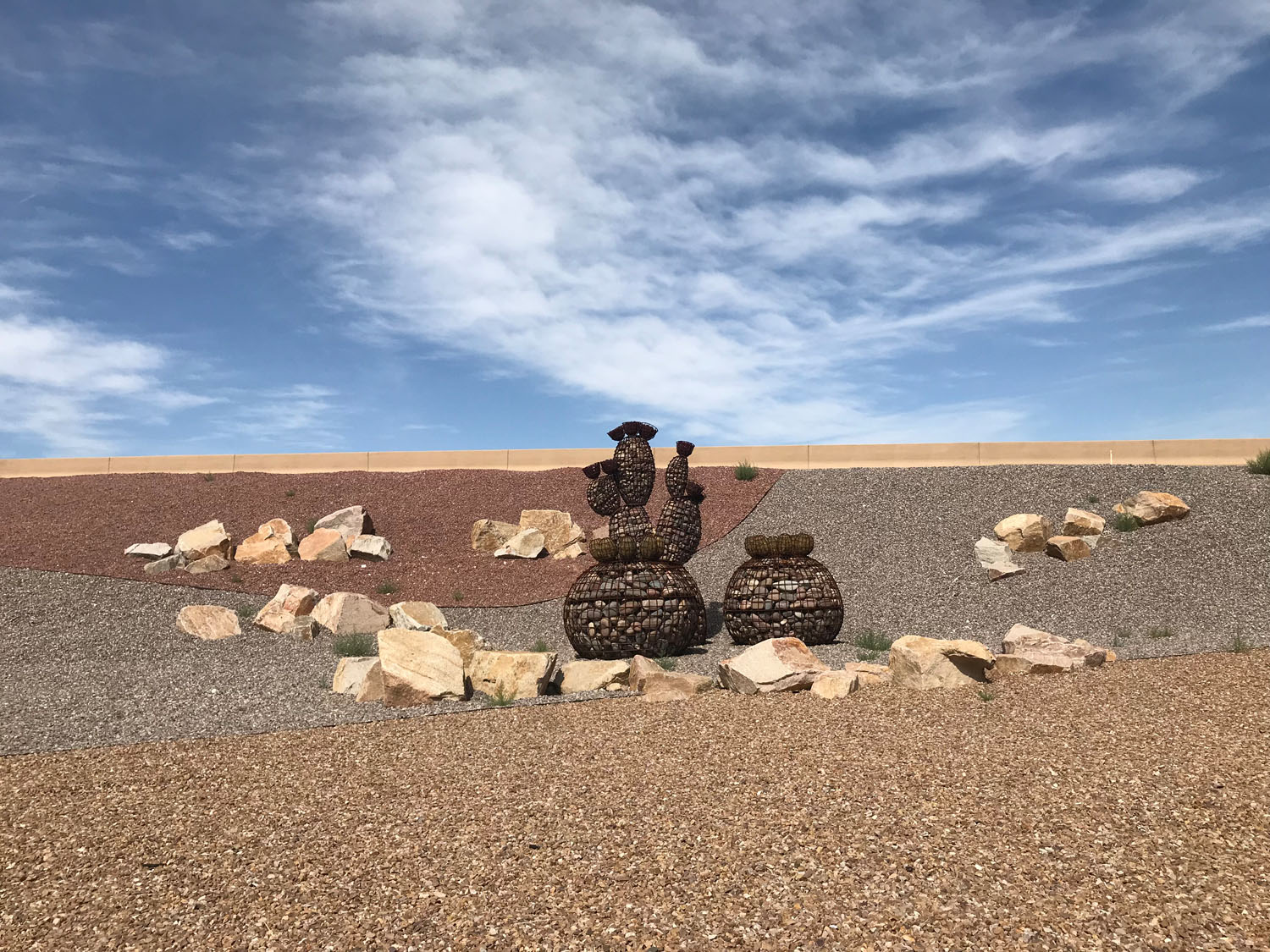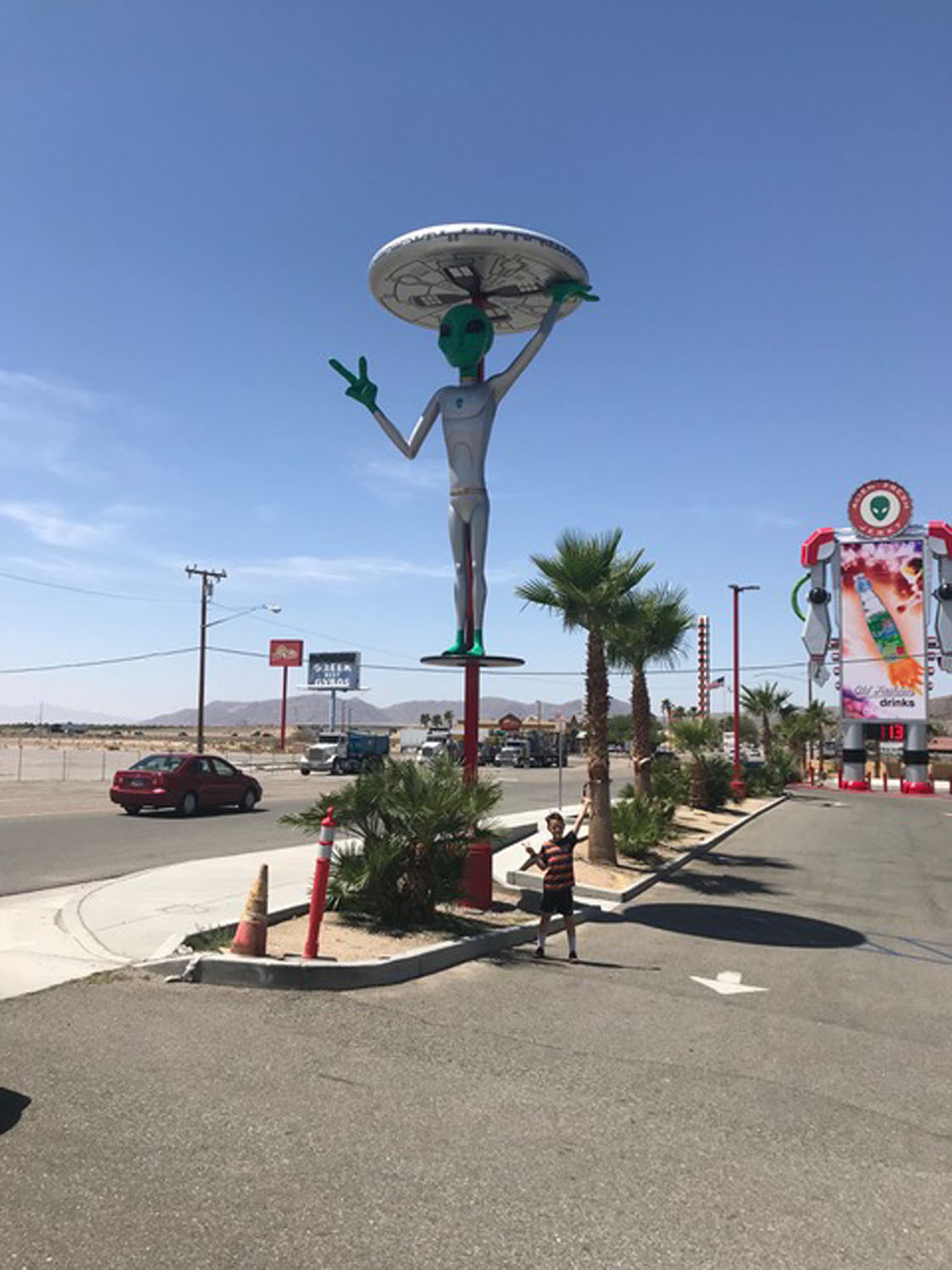1.
On a Saturday morning in early June, just before the heat spikes, I set out with my eight-year-old son from Las Vegas to Los Angeles. We start the way I drive to work—north on Spencer Street past rows of midcentury ranch houses; left around the playgrounds of William E. Orr Middle School; then right on East Katie where, just past Algonquin, I see two burned-out truck trailers at the edge of the Boulevard Mall parking lot. One has holes in its sides like white paper someone held a lighter to, blew out the flame, and burned again and again. Still, standing on its wheels and struts, it seems positively stalwart compared to its companion, collapsed on its belly—a gesture of abjection, it feels, but also prayerful? Inside the trailer shells I glimpse blankets and bottles and a plywood shed. I don’t dwell, though. I’m on my way to get waffles for my boy.
At TIABI Coffee & Waffle, we walk through a glass door into the other side of the Las Vegas Valley. I show the clerk a picture of a face-waffle they made for us several years ago. The woman at the iron glances over. “I can top that,” she says.
The burned-out truck, the face-waffle: These are the poles between which my experience of Las Vegas is strung. This is a place of woe and wonder. It’s where you see a man at an interstate off-ramp asking for change with a full-grown pit bull slumped on his back, a paw draped over each of the man’s shoulders. It’s also the place where a couple—one very tall and bearded, one short and wispy and clean-shaven—created an independent bookstore and sanctuary for artificial birds on East Fremont Street, among a cluster of hipster retail, neon, and street art that feels like Marfa meets Burning Man.
In Las Vegas, I’ve gathered with writers at the edge of the desert, heard songs of lament and praise as the light dims from high-beam-in-the-eyes bright to soft orange to purple-blue. And I’ve driven past an elderly woman in a wheelchair-scooter, rolling down a side street, under full desert sun.
The word for this place is strange—and wonderful, I hasten to add, though it makes me a bit sad that I need to, that people don’t understand the meaning of the word strange.
2.

The city of Las Vegas is a small part of what’s commonly called by that name. The midcentury neighborhood Paradise Palms (where I live), the University of Nevada, Las Vegas (where I work), and the world-famous Las Vegas Strip (which I scrupulously avoid) are all in unincorporated Clark County, not the city proper. “This is not what you should call a city,” an old Vegas hand, the real-estate developer Michael Saltman, told me over Italian food at a strip mall, cooked by a man with a saga. “It’s more like an area.”
There’s the classic postwar, car-city sprawl but somehow, as the strip malls and large signs lope farther and farther into the desert, it feels more than that. What’s the emotional cadence to Las Vegas’s sprawl? I wonder about this as my son and I head out via I-15 South, as we pass the Mandalay Bay, site of the recent ignominy, as we come to experience the world at seventy-five miles an hour. Then the peculiar frisson to life here comes home to me: Vegas is so much about movement, yet its gifts are so much in slowness. It is a landscape of neon signs (lit by excited electrons) and amphibians who stand and stare with a rare, occasional blink. On this road, once, I saw a bumper sticker on a truck: did you move here to be in a hurry? I made note of it on my phone’s voice-memo app, at seventy-five mph.
Today, the boy as my copilot, playing NBA LIVE in the backseat, I decide to pay attention, to the presences and to the emptiness. Then, just before the Cactus Avenue underpass, something catches my eye, and I pull to the side of the road to observe what man has made of this slow and furious place, what we have done to try to contain nature—to build metal meshing around it, to hold it in some form.
3.

It’s a Sunday but the lobby of the Baker, California, post office is unlocked, PO boxes in a cold L-shaped room (so many little spaces, each with its own lock, its own distinct point of entry). The bulletin board announces job openings at Fat Burger and T-shirts for sale by the Baker Area Chamber of Commerce ($15; $18 for a V-neck). Valdez Tax Services has left a business card. So has Silver Valley Septic. The Ironwood Christian Academy is accepting applications for the 2018–2019 school year. They offer a Bible-based curriculum, character development, practical math, phonics-based reading, and cursive.
There are so many signs of life, but we haven’t talked to anyone outside the car since TIABI, so I call the number on the sign a few paces from the post office, offering one-, two-, and three-bedroom homes. “The person you are trying to reach is not accepting calls at this time. Please try your call again later.” The message is repeated in Spanish, followed by a busy signal.
I take this as another sign—of the desert’s ambivalence to what’s here, and who. In cities, old signs get torn down. In wetter climates, they might decompose. In the rural desert, things just sit there, at the mercy of the sun. This idea of the desert as a kind of open-air sepulcher is a theme that recurs to me on this drive from Vegas to L.A.
4.

Luis Ramallo, an electrician who emigrated to the US from Argentina in 1988, was struggling to support himself in construction when he started selling jerky, olives, honey, and pistachios on the roadside where Highways 93 and 318 intersect, about fifty miles east of Area 51. He made nearly $1,000 his first day. When police eventually drove him off, he noticed, on the green card he showed them, the phrase “resident alien.” That’s how the idea for his alien-themed store was born.
A year later, in 2000, stopping in Baker, California, to get gas, he discovered the perfect location. “Now,” he says in a video portrait (one of several online), “we are 100 percent involved with the alien theme.”
My son likes beef jerky. He also wants a scorpion pop—a yellow lollipop with a scorpion in the middle. I tell him he can have the lollipop if he eats the scorpion and he takes the deal. Alien Fresh Jerky does sell jerky—a dozen or more kinds, including Abducted Cow Pineapple Teriyaki; Filet Mignon—Weed Killer Hot; and Honey Chipotle. It also has a wall of novelty hot sauces, including one with a skeleton’s head as the cap, with a piece of black felt acting as a cloak. The hot sauce is called ASS REAPER. Underneath the name, the tagline: “That’s your ass now.”
Also on sale: alien-themed toys; garlic gloves; books such as “Crop Circles: The Bones of God”; “Ancient Aliens: The Coloring Book,” and “The Alien World Order: The Reptilian Plan to Divide and Conquer the Human Race”. One label says “hottest fuckin’ wing sauce.” My son tells me to stop cursing. “I can’t help it,” I say, laughing. “It’s on the label!” He asks if he can read the label, too.
On the way out, we realize that the store itself—flanked with laser cannons, wheels at the building’s four corners, and a command center over the entrance with two animatronic aliens—is itself a space ship.
“For me,” Ramallo says in a video, “it’s a challenge, as an immigrant, and personal for me to say I created something.”
It reminds me of the phrase I adopted when people asked me about living in Las Vegas, and when I didn’t have time for a proper briefing. “Life on Mars,” I would say.
5.

We see so much more. We see the world’s tallest thermometer, and a gaggle of trucks that paint lines on roads; they’re off duty, parked near one another like in an old-fashioned wagon circle, dried paint globs at the end of massive nozzles. We see a four-door truck with a purple suitcase and a fold-up wheelchair in the back. We see solar fields and an Army depot with garbage bins painted in camouflage. We see the ruins of the Bun Boy Motel. We see a “Trucker’s Chapel” and signs for Ghost Town Road and the All Day Egg Café. We see a full roll of toilet paper next to a rusted can just a few feet before a sign that says $1,000 fine for littering.
There are many places we don’t stop. I list them to my son, including Yermo. (“What’s Yermo?” he asks. “I don’t know! That’s the point I’m making!”)
We do stop for gas, and there we see Joey Riha leaning against his blue Chevy Lumina. His sign asks for money for a traveling memorial to his father, who died in April. They had just reconnected after Joey got clean. He’s been to Maroon Bells with the ashes and to the Vegas strip. He’s trying to get to the ocean.
Usually, I encounter people asking for money to get a meal, get some rest. It feels fitting that, on this drive, I’d find someone asking for money so that he can stay on the road.
At one stop—in Zzyzx, California, the site of an old spa made in the 1940s by a radio evangelist—it came home to me, this tension between presence and motion. Zzyzx is part ruin, part research center run by California State University. I wanted to see it but I also felt gnawed on by the mounting traffic from Vegas to L.A. on a Sunday. I drove past the signs that firmly instructed me not to drive past them, onto the boulevard for Soda Springs. Then I saw a green Toyota Land Cruiser pull out and follow me.
“I just have one question,” the man said when I stopped, and he pulled up even with me. “Why did you ignore those signs?” I felt so embarrassed. I couldn’t have felt worse if he was angry or mean. Why did I ignore those signs? Because I want to see the site and not get farther behind the traffic. I want to see where I am and get where I’m going.
This dispatch is from #VQRTrueStory, our social-media experiment in nonfiction, which you can follow by visiting us on Instagram: @vqreview.







